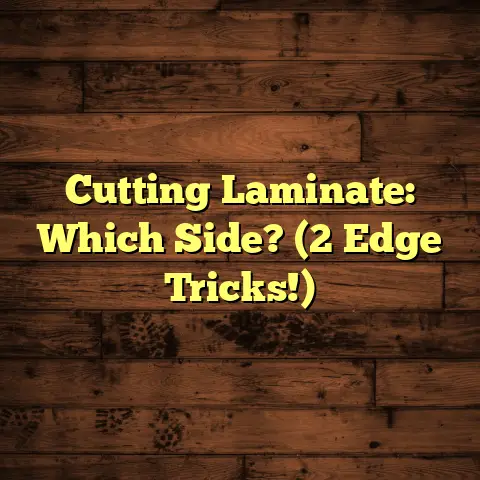Outdoor Floor Tiles: What Are Your Options? (5 Best?)
Choosing the right outdoor floor tiles is a bit like picking the perfect pair of shoes – they need to look good, feel good, and hold up against whatever life throws at them.
That’s why I’m diving deep into the world of outdoor floor tiles to give you the lowdown on what works, what doesn’t, and how to make the best choice for your space.
Understanding Outdoor Flooring: An Overview
Think about it, outdoor flooring isn’t just about aesthetics. It’s about creating a space that can handle everything Mother Nature throws its way.
We’re talking rain, snow, scorching sun, and even the occasional rogue BBQ spill. That’s a whole different ballgame than your cozy indoor floors, right?
Outdoor flooring needs to be tough, durable, and able to resist the elements. Indoor tiles? Not so much.
I’ve seen countless patios ruined by choosing the wrong materials. Cracking, fading, and slippery surfaces – it’s a nightmare!
That’s why understanding the difference between indoor and outdoor flooring is key.
Factors to Consider When Choosing Outdoor Floor Tiles
Before we jump into the tile options, let’s talk about what makes a tile a good fit for the great outdoors.
These are the things I always consider before recommending anything to my clients.
-
Durability: Can it handle the weather? We’re talking rain, snow, UV rays, and those crazy temperature swings.
-
Slip Resistance: Safety first! Especially when things get wet. You don’t want your guests doing the slip-n-slide on your patio.
-
Maintenance: How much time do you want to spend cleaning and sealing? Some tiles are super low-maintenance, while others need a little extra TLC.
-
Aesthetic Appeal: Does it match your style? The right tile can totally transform your outdoor space.
-
Installation: Are you a DIY warrior, or will you need to call in the pros? Installation costs can vary widely depending on the tile type.
The Top 5 Outdoor Floor Tile Options
Alright, let’s get to the good stuff! Here are my top 5 picks for outdoor floor tiles, based on years of experience and countless successful projects.
Ceramic and Porcelain Tiles
Ceramic and porcelain tiles are made from clay mixtures that are fired at high temperatures.
Porcelain is denser and less porous than ceramic, making it more resistant to water absorption.
Think of porcelain as the tougher, more sophisticated cousin of ceramic.
Aesthetically, these tiles are incredibly versatile. You can find them in a huge range of colors, patterns, and textures.
Want a rustic look? Go for a textured, earthy-toned ceramic.
Prefer something sleek and modern? Opt for large-format porcelain tiles with a minimalist design.
Durability-wise, porcelain is the clear winner for outdoor use. It’s incredibly resistant to moisture, stains, and scratches.
Ceramic can work too, but make sure it’s rated for outdoor use and properly sealed.
As for maintenance, both are pretty easy to clean with just soap and water.
Popular Brands and Styles:
-
Daltile: Known for their wide selection of porcelain and ceramic tiles, including many outdoor-rated options.
-
Emser Tile: Offers stylish and durable tiles with unique designs.
-
Florim: Italian brand specializing in high-end porcelain tiles with exceptional quality.
Natural Stone Tiles
Ah, natural stone! There’s just something so timeless and elegant about it.
We’re talking slate, granite, travertine, and more. Each stone has its own unique character and texture.
Slate is known for its natural cleft texture and earthy tones. Granite is incredibly durable and comes in a variety of colors and patterns.
Travertine has a warm, creamy color and a distinctive pitted surface.
The beauty of natural stone is that no two tiles are exactly alike.
It adds a touch of luxury and sophistication to any outdoor space.
But there are some drawbacks to consider.
Natural stone can be more expensive than other options.
It also requires regular sealing to protect it from moisture and stains.
Some stones, like slate, can be slippery when wet, so you’ll want to choose a textured finish for safety.
Sealing and Maintenance:
-
Sealing: Apply a penetrating sealer every 1-2 years to protect the stone from water and stains.
-
Cleaning: Use a mild detergent and a soft brush to clean the tiles regularly. Avoid harsh chemicals that can damage the stone.
Composite Decking Tiles
Composite decking tiles are made from a blend of wood fibers and plastic.
Think of it as a wood-look without all the maintenance headaches.
The big advantage of composite is its durability and resistance to the elements.
It won’t rot, warp, or splinter like real wood. Plus, it’s super easy to install.
Most composite tiles come with an interlocking system that snaps together in minutes.
Design-wise, you can find composite tiles in a variety of colors and wood-grain patterns.
Some even have a textured surface that looks and feels like real wood.
Advantages of Composite Tiles:
-
Sustainability: Made from recycled materials.
-
Easy Installation: Interlocking system for quick and easy DIY projects.
-
Low Maintenance: No need to stain, seal, or paint.
Concrete Pavers
Concrete pavers are made from a mixture of cement, aggregates, and pigments.
They’re incredibly strong and durable, able to withstand heavy foot traffic and harsh weather conditions.
You’ve probably seen them used in driveways, patios, and walkways.
One of the great things about concrete pavers is the variety of designs and patterns you can achieve.
They come in different shapes, sizes, and colors. You can create intricate patterns or keep it simple with a classic running bond.
If a paver gets damaged, it’s easy to replace. Just pop it out and put in a new one.
Design Options and Patterns:
-
Running Bond: A classic pattern where the pavers are offset by half their length.
-
Herringbone: A zigzag pattern that adds visual interest.
-
Basket Weave: A pattern that resembles a woven basket.
Vinyl Tiles
Now, you might be surprised to see vinyl on this list, but hear me out.
Luxury vinyl tiles (LVT) have come a long way in recent years.
They’re now incredibly realistic, durable, and water-resistant.
Some LVT is specifically designed for outdoor use, with UV-resistant coatings and enhanced durability.
The big advantage of vinyl is its comfort underfoot. It’s softer and warmer than stone or concrete.
Plus, it’s super easy to clean.
Design-wise, you can find vinyl tiles that mimic the look of wood, stone, and even ceramic.
Benefits of Vinyl Tiles:
-
Water Resistance: Perfect for poolside areas.
-
Comfort Underfoot: Softer and warmer than stone or concrete.
-
Easy to Clean: Just sweep or mop.
Comparative Analysis of the Top 5 Options
Okay, let’s break it down. Here’s a comparison table summarizing the key features of each tile type:
| Feature | Ceramic/Porcelain | Natural Stone | Composite Decking | Concrete Pavers | Vinyl Tiles |
|---|---|---|---|---|---|
| Durability | Good (Porcelain Excellent) | Excellent | Excellent | Excellent | Good |
| Maintenance | Low | Medium | Low | Low | Low |
| Slip Resistance | Medium (Textured Better) | Medium (Textured Better) | Medium (Textured Better) | Medium | Good |
| Aesthetic Appeal | High | High | Medium | Medium | Medium |
| Cost | Medium | High | Medium | Medium | Low |
So, which option is right for you? It depends on your specific needs and preferences.
-
Poolside: Vinyl or porcelain tiles are great choices due to their water resistance and comfort underfoot.
-
Patio: Natural stone, concrete pavers, or composite decking can create a beautiful and durable outdoor living space.
-
Garden Paths: Concrete pavers or natural stone are ideal for creating charming and functional pathways.
Conclusion: Making Your Choice
Choosing the right outdoor floor tiles can feel overwhelming, but it doesn’t have to be.
By understanding the different options available and considering your specific needs and preferences, you can make an informed decision that enhances your outdoor living experience for years to come.
Remember, the best tile is the one that not only looks great but also stands the test of time.
So, take your time, do your research, and choose wisely! Your dream outdoor oasis awaits.





